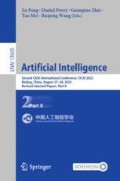Abstract
The photovoltaic power generation is affected by many nonlinear variables so, it is very difficult to detect the faults. In order to detect such faults very easily and effectively, a photovoltaic hot spot detection method based on kernel entropy component analysis (KECA) and information gain is proposed in this paper. The method first uses the kernel entropy component analysis to extract the information characteristic data of the sample, then uses the normal sample and the information gain to determine the detection threshold, and finally calculates the detection variable of the faulty sample and compares it with the detection threshold to determine whether any hot spots fault exist. Experiments show that this method can make full use of the inherent information in the data, and exhibits a good hot spot detection effect.
Access this chapter
Tax calculation will be finalised at checkout
Purchases are for personal use only
References
Fadhel, S., Diallo, D., Delpha, C., et al.: Maximum power point analysis for partial shading detection and identification in photovoltaic systems. Energy Convers. Manag. 224, 113374 (2020)
Basnet, B., Chun, H., Bang, J.: An intelligent fault detection model for fault detection in photovoltaic systems. J. Sens. 2020, 1–11 (2020)
Appiah, A.Y., Zhang, X., Ayawli, B.B.K., et al.: Review and performance evaluation of photovoltaic array fault detection and diagnosis techniques. Int. J. Photoenergy, 1–19 (2019)
Wu, Z., Hu, Y., Wen, J.X., et al.: A review for solar panel fire accident prevention in large-scale PV applications. IEEE Access 8, 132466–132480 (2020)
Karimi, M., Samet, H., Ghanbari, T., et al.: A current based approach for hotspot detection in photovoltaic strings. Int. Trans. Electr. Energy Syst. 30(9), e12517 (2020)
Henry, C., Poudel, S., Lee, S., et al.: Automatic detection system of deteriorated PV modules using drone with thermal camera. Appl. Sci. 10(11), 3802 (2020)
Zhang, Y.M.: Research and implementation of photovoltaic panel hot spots detection robot. Tianjin University of Technology (2020)
Lazzaretti, A.E., Costa, C.H.D., Rodrigues, M.P., et al.: A monitoring system for online fault detection and classification in photovoltaic plants. Sensors 20(17), 4688 (2020)
Appiah, A.Y., Xinghua, Z., Ben, B.K.A.A., et al.: Long short-term memory networks based automatic feature extraction for photovoltaic array fault diagnosis. IEEE Access 7, 30089–30101 (2017)
Jenssen, R.: Kernel entropy component analysis. IEEE Trans. Pattern Anal. Mach. Intell. 32(5), 847–860 (2010)
Deng, M.Y., Liu, J.C., Xu, P., et al.: New fault detection and diagnosis strategy for nonlinear industrial process based on KECA. CIESC J. 71(05), 2151–2163 (2020)
Zhou, H.D.: Research on condition recognition methods of rolling bearings based on kernel entropy component analysis. Huazhong University of Science and Technology (2017)
Chen, J., Yu, J.: Independent component analysis mixture model based dissimilarity method for performance monitoring of non-Gaussian dynamic processes with shifting operating conditions. Ind. Eng. Chem. Res. 53(13), 5055–5066 (2014)
Gomez-Chova, L., Jenssen, R., Camps-Valls, G.: Kernel entropy component analysis for remote sensing image clustering. IEEE Geosci. Remote Sens. Lett. 9(2), 312–316 (2012)
Shekar, B.H., Sharmila, K.M., Mestetskiy, L.M., et al.: Face recognition using kernel entropy component analysis. Neurocomputing 74(6), 1053–1057 (2011)
Xia, Y., Ding, Q., Jiang, A., et al.: Incipient fault diagnosis for centrifugal chillers using kernel entropy component analysis and voting based extreme learning machine. Korean J. Chem. Eng. 39(3), 504–514 (2022)
Zhou, H., Zhong, F., Shi, T., et al.: Class-information-incorporated kernel entropy component analysis with application to bearing fault diagnosis. J. Vib. Control 27(5–6), 543–555 (2021)
Xia, Y., Ding, Q., Li, Z., et al.: Fault detection for centrifugal chillers using a Kernel Entropy Component Analysis (KECA) method. Build. Simul. 14(1), 53–61 (2021)
Xu, P., Liu, J., Shang, L., et al.: Industrial process fault detection and diagnosis framework based on enhanced supervised kernel entropy component analysis. Meas. J. Int. Meas. Confed. 196, 111181 (2022)
Li, Y., Wang, Y., Wang, Y., et al.: Quantum clustering using kernel entropy component analysis. Neurocomput. (Amst.) 202, 36–48 (2016)
Shi, J., Jiang, Q., Zhang, Q., et al.: Sparse kernel entropy component analysis for dimensionality reduction of biomedical data. Neurocomput. (Amst.) 168, 930–940 (2015)
Qi, Y.S., Zhang, H.L., Wang, L., et al.: Fault detection and diagnosis for chillers using MSPCA-KECA. CIESC J. 68(04), 1499–1508 (2017)
Chen, H., Yi, H., Jiang, B., et al.: Data-driven detection of hot spots in photovoltaic energy systems. IEEE Trans. Syst. Man Cybern. Syst. 49(8), 1731–1738 (2019)
Author information
Authors and Affiliations
Corresponding author
Editor information
Editors and Affiliations
Rights and permissions
Copyright information
© 2022 The Author(s), under exclusive license to Springer Nature Switzerland AG
About this paper
Cite this paper
Jiang, S., Yi, H. (2022). Photovoltaic Hot Spots Detection Based on Kernel Entropy Component Analysis and Information Gain. In: Fang, L., Povey, D., Zhai, G., Mei, T., Wang, R. (eds) Artificial Intelligence. CICAI 2022. Lecture Notes in Computer Science(), vol 13605. Springer, Cham. https://doi.org/10.1007/978-3-031-20500-2_40
Download citation
DOI: https://doi.org/10.1007/978-3-031-20500-2_40
Published:
Publisher Name: Springer, Cham
Print ISBN: 978-3-031-20499-9
Online ISBN: 978-3-031-20500-2
eBook Packages: Computer ScienceComputer Science (R0)

